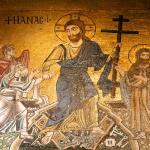![Sandro Botticelli [Public domain], via Wikimedia Commons](https://wp-media.patheos.com/blogs/sites/290/2017/04/Augustine_of_Hippo_Sandro_Botticelli.jpg)
Rod Dreher positions himself in The Benedict Option in a way that makes this review require a bit of personal introduction. We both seem to agree that testimony is important.
I grew during the 80s and 90s in a lay Catholic missionary family that spent a decade as affiliate members and on-site missionaries with a charismatic covenant community founded in Akron, Ohio. That community used a rulebook, A Cultural Approach to Christian Community, published in 1993 by the founder, Richard Herman.
Apart from the community years, my father has worked as a full-time Catholic evangelist for nearly forty years with no degrees, books, or other publications to his name. The core kerygmatic content of his message has not changed in any of the essentials: the love of God, salvation in Jesus Christ, repentance in and through the sacraments (especially confession), and empowerment in the Holy Spirit and the life of the Church. This is all narrated through my father’s conversion story, where he was healed from an addiction to heroin and a life of crime by the grace of God manifest in the love of his adoptive parents, my abuelitos, and the spiritual direction of an Irish priest, Fr. John O’Malley, who baptized me.
I graduated from Franciscan University of Steubenville and then matriculated through various institutions for graduate studies and academic appointments: University of St. Thomas, Ohio State University, Wabash College, University of North Dakota, and, finally, the University of British Columbia, where I work as a philosopher of education. I serve the church in my local archdiocese as a pastoral-philosopher in residence at St. Mark’s College (where I have taken vows of fidelity and hold a mandatum) and also on the web, as the editor of the Patheos Catholic blog channel.
I mention these personal details to make it clear that I am a reader of Dreher who takes his project seriously and even personally. This is not to suggest that I am a holy or good person. Far from it. It only means that I accept the burden to read Dreher and his book, both of which I’ve been hearing about for several years now, within its testimonial context and my own. Many of the critiques I’ve read thus far strike me as those who have certain investments in the book’s thesis but not many. The ones that seem to like it don’t tell me much about why except that they agree with its descriptive claims. Others, like the lumped-together critique written by Jamie Smith for the Washington Post seemed downright petty (until I read Dreher’s response to it).
I don’t know Dreher personally nor had I heard of him before a handful of years ago, but we do share some things in common. One is living through the conservative movement in the United States (albeit one generation removed) and feeling increasingly odd about its longevity in the public square. My radio blared James Dobson’s Focus on the Family along with Rush Limbaugh and Dr. Laura. I cut my first public-religious intellectual teeth on Neuhaus in First Things and have written a few things for their online catalog. I do not balk at the label conservative and am even fond of it. The term ‘traditionalist’ is, to my knowledge, a more recent convention and in its basic orthodox sense (with a lowercase o) I suppose I would use it as well.
Like Dreher, I have known many priests and religious, who formed me in ways far more positive than negative, and several of them are professed to monastic and mendicant religious orders. When I first saw Into Great Silence, I wept with awe. I am totally with Dreher on this; I hold religious life in high esteem. I am sure that Dreher is familiar with secular religious orders, such as the lay Benedictines (he quotes one in the book), but I sometimes wonder if he perhaps might consider joining one of them instead of inventing his own sect of “Benedict Option Christians.” Of course, this would perhaps involve him returning to the Roman Catholicism he left behind for Orthodoxy, a point I’ll return to later.
Also like Dreher, I have a deep love of Dante and the Ptolemaic and analogical imagination of the Ancients and Medievals. C.S. Lewis’ magnificent book, The Discarded Image, was taught to me in my first advanced philosophy class at Franciscan University, “Philosophy of Dante.” It was freshman year and there were four students in Dr. Spinnenweber’s last class before he retired that year. It changed my life. I suspect I would enjoy Dreher’s book on Dante.
Again like Dreher, I am wary of the disenchantment of modernity and also like him I sometimes succumb to platitudes and assertions that turn into an oversimplified chronological timeline. His sketch in the second chapter of The Benedict Option was as off-putting as it was convicting for having said similar things myself. I too used to think I could pin all present ills on Descartes and others. Imagine my surprise when I realized that the far left postcolonialist critique is identically opposed to Descartes and the rest! In the end, though, I take his point, although today I am not as certain that the narrative of modernity has been settled by anyone, and I do agree that Charles Taylor has come the closest to hitting the mark in A Secular Age.
What Dreher and I probably agree on most is our mutual esteem for the life and thought of Pope Benedict XVI. However, I am not so sure that Dreher admires Benedict XVI enough. As we will see, he clearly has misunderstood Benedict’s teaching on eros in Deus Caritas Est (followed up on in his 2007 Lenten Reflection on “the mad eros of the Cross”) and Benedict’s engagement with modernity from his early work within the Nouvelle Théologie and influence on Vatican II to his more recent dialogue with Marxist atheist and critical theorist Jurgen Habermas, published as The Dialectics of Secularization: On Reason and Religion. But I do take seriously the fact that Dreher seems to admire Benedict XVI as a contemporary inspiration for his option rooted in St. Benedict of Nursia.
In what follows, I will set out to do three things: (1) ask a series of basic questions about The Benedict Option, (2) outline confusions I find in the book, and (3) demonstrate the ironies and absurdities under which the book eventually becomes a self-parody and contradiction to itself. It is important, however, to place these critical observations within the context of that which we agree on and my own entry into Dreher’s testimonial conversation noted above.
***
The first questions would be about the title and subtitle. What does “The Benedict Option” mean? Who is this “Benedict”? What is this “option”?
We can answer the first question easily, at first. The Benedict of The Benedict Option is St. Benedict of Nursia, founder of the Benedictine Order. There are others who Dreher gathers together under the banner of “Benedict,” most of all the philosopher Alasdair MacIntyre and, as we have seen, Pope Benedict XVI.
However, as this unravels we realize that asserting these sources of authority and inspiration hardly makes any sense of their actual role for the book’s argument. After reading the introduction, I was shocked to find Dreher refer to the Rule of St. Benedict in anecdotal terms, from monks at present-day Nursia, and to make no effort whatsoever to describe who St. Benedict of Nursia was and what the Benedictine Order was in relation to its own time.
There are two fine and accessible entries in the Catholic Encyclopedia at New Advent that provide more detail and a fairly direct rebuke of Dreher’s made up idea that “Saint Benedict, the sixth-century father of Western monasticism, responded to the collapse of Roman civilization by founding a monastic order.” Far from it when we compare the competing source that reveals that “St. Benedict did not, strictly speaking, found an order; we have no evidence that he ever contemplated the spread of his Rule to any monasteries besides those which he had himself established” and, following that clarification, that “[St. Benedict’s] so-called order was not established to carry on any particular work or to meet any special crisis in the Church, as has been the case with other orders.” Right away we realize that Dreher is playing fast and loose with the few things we know about St. Benedict. No wonder Dreher substitutes anecdote for Church history.
More scandalous to me was that, after invoking MacIntyre as the contemporary philosophical insight for The Benedict Option, Dreher only mentions MacIntyre on four of the next 237 pages, three of them in a quick, self-affirming gloss of After Virtue on pages 16-18. If this is the standard for the lectio and disputatio of “Benedict Option Christians” then it is very hard for me to see it as conservative, traditional, or worthy of invoking St. Benedict, MacIntyre, or Pope Benedict XVI. It is an emotivist critique of emotivism.
But what is this “option”? This is not easy to understand. The language of the “turn” of theory seems to be at play here. The linguistic turn, the ontological turn, the material turn, and so on. But in this case, the word ‘option’ implies a choice. However, Dreher doesn’t explain what the other choices are, even when he should know that Benedictine spirituality is not the only option for Christians. Maybe he shouldn’t be entirely ecumenical, but the idea of this option over here and that option over there is an absurdity for a book that is trying to argue that the optional nature of religion (a key feature of secular society in Taylor’s analysis) is a problem. So who knows what this “option” idea is.
Now for the subtitle: A Strategy for Christians in a Post-Christian Nation. Perhaps Dreher didn’t choose this subtitle. Maybe Sentinel, his press, forced it upon him. I hope that is the case because the subtitle threatens to dismantle the entire book, especially in the final chapter where Dreher quotes a Presbyterian pastor who seems able to judge what is and is not truly Benedictine, saying, “[The Benedict Option] cannot be a strategy for self-improvement or for saving the church or the world.” If The Benedict Option cannot be those things then what does the subtitle mean?
The other glaring question is how one squares a universal church with “a Post-Christian Nation.” Does this refer to the nation-state of the USA? Or does it refer to some other sense of “nation”? Is this an option for Americans, drawn on a Roman saint, a British philosopher, and a German Pope? Of course, one need not only use local sources, but the book works seamlessly between a national sense, a sense of “the West,” and occasionally the world. There is a serious theological problem here, of course, since the church is universal in a sense that goes well beyond the demographic or geopolitical modern sense.
The last question, before I move on the claims I find to be confused, might be a bit more subtle. What is Dreher’s method in this book? The first answer is that he may not have one. It comes across in the way a blog post does: direct, first-person, and with no sense of internal structure or order. Dreher enjoys telling stories and some of them he tells well enough, but many of them he tells at a moment when one would expect him to fill the gaps of an argument. Story, for Dreher, is something of a deus ex machina. The stories he relies on most heavily are woven into his analysis and add to his credibility, most of all from the monks at Nursia, but they also replace more careful work.
This issue here is not only that this journalistic method is profoundly modern (in a book that rails against modernity) but most of all that it is weak. There is little to nothing to support his opening claims which result in the middle of the book: a set of assertions made with no argument, platitudes invoked with no evidence. Nothing follows. Most of all, the book shows no ability to consider objections or to test its ideas against a possible weakness. The journalistic method takes a “report the facts” approach and uses philosophical sources as arguments from authority, not as aids in thinking things through. Whatever the method might be, it is not a thoughtful one.
***
Here are a series of confusions.
The first is the confusing matter of the Middle Ages. Dreher says two different things about the Middle Ages in his book. On the one hand, he sees the Middle Ages as the period that required a radical retreat in the face of the fall of Rome. On the other hand, he sees the Middle Ages as a period of enchantment and deep faith. These two stories are both vastly oversimplified, but they are quite off when they are both said to be true simultaneously. How can it be the case that when Rome fell the Benedictines endured the Middle Ages guided by their Rule and, also, that the fall of Christianity happened, like Rome, after the end of the Middle Ages? Anyone can see that this story makes no sense logically. Historically, it makes even less sense.
Dreher seems to want to make a Gibbonsesque analogy between the fall of Rome (a very tired conservative cliche) and the fall of the West. Of course, both of those falls can be disputed, but so be it. He also wants to make his Benedict Option function as the response to the fall of Rome/West. But to do this he runs into the need to explain the fall of the West in terms of its departure from the Middle Ages, the very period that began in the retreat after the fall of Rome. The analogy doesn’t work and the historical record only throws more curve balls, like the mendicant secular orders that reformed the monastic tradition with options to be in the world, like Francis and Dominic. Or, even earlier, like Augustine who wrote his diaries as the Vandal armies descended on North Africa. Augustine, of course, argued in his City of God that Christianity was not responsible for the fall of Rome as many people said it was, a tough detail for Dreher’s thin and mostly invented history to contend with.
A second confusion is Dreher’s abstraction of Christianity. The book uses Roman Catholic sources and characters, but also includes a smattering of Protestants and a few Orthodox. By the end of the book, Dreher begins to sound like he’s written a manifesto, calling his new order “Benedict Option Christians.” Earlier he calls these “Benedict Option Churches” and “Benedict Option believers.” Just what are these churches? And what are the tenets of this belief? The book itself, with no ecclesiastical authority whatsoever and no scholarly credibility to speak of? This is tremendously abstract because there is obviously a real Benedictine Order that follows the real Rule of St. Benedict, which includes a lay apostolate for people like Dreher. Now, of course, this also implies that one be a Roman Catholic, which Dreher no longer is. In yet another boldly modern move, Dreher writes as if he can write on behalf of all of the Christian denominations that he has hopped from and to. Surely, someone so concerned with obedience and submission and the problems of modern excess can see that acting subjectively abstract about what is quite objectively concrete is a silly routine and a bad argument.
The third confusion is his notion of education, which slips into schooling and includes prescriptive orders on public schools, classical schools, and homeschooling. This has a serious theological problem. The Catholic idea of education is rooted in the practical idea that “parents are the primary educators of their children.” Elsewhere Dreher poo-poos the family a bit, which I found odd, but of course the idea of a parent here can be understood culturally even in scripture, as we see in Hannah handing over Samuel to Eli. The point is that Dreher does not understand what education is and means, yet he is perfectly happy to give orders. He never once mentions mystagogy (although he talks about liturgy); only pedagogy seems relevant to him.
This educational critique underscores another major confusion that runs throughout the entire book. Dreher mistakes issues with ideas and thinks that an assertion about the former can solve the problems with the latter. He does this constantly and it borders on coming off as crazy. For instance, his subtitle “Tighten Church Discipline” is a meaningless slogan that comes with a story of Southern Baptist pastor’s church’s strict rule enforcement but nothing more. How is that to be taken seriously? And how is that somehow not hyper or pre-modern? Laws enforcement is hardly a new thing, is it?
The fourth confusion is to be found in Dreher’s understanding of eros. His use of it in chapter 9, “Eros and the New Christian Counterculture” (and also in the section of chapter 2, “The Triumph of Eros”) directly betrays his own key source, Benedict XVI. I will not torture this point too much. Dreher quotes Benedict XVI directly from Deus Caritas Est and tries to support the idea that that eros is somehow chastened by agape, exclusively to exist in marriage. However, Benedict XVI is clear when he writes, “We have seen that God’s eros for man is also totally agape.” The analogy to marriage is rooted in Divine love, not vice versa. This reversal is an elementary theological blunder. Even more radical, however, is Benedict’s XVI meditation on the “mad eros of the Cross” in his Lenten reflection of 2007, which followed the encyclical. The point, again, is theological: eros is not an instrumental issue, it is a profound idea that goes back at least to Plato.
This note on Plato brings up my fifth and final note of confusion, regarding Dreher’s sense of the canon of literature, Western civilization, and the untouched era of pre-Christian classical antiquity. If modernity is terrible because of its rampant unbelief, then what do we make of Homer, Hesiod, Herodotus, Thucydides, the pre-Socratics and more? And not only the Greeks. What about the Assyrians, Persians, Babylonians, the Mayans, and more? Dreher’s anemic sense of history shows its lack of reflexivity and a fundamental problem in its anthropology. As much as Rome was the Divine City, it was not Augustine’s City of God. It was Pilate’s kingdom, not Christ’s. Here, again, the tension in Dreher’s history and historiography demostrates how poorly thought out the story and argument is and his application of this through so-called “classical” education makes it rather laughable. After all, most classical curricula, as with most traditionalist things en vogue today, are a recent convention, based on presentist misunderstandings of the past.
***
I would like to end by noting some ironies that might even be called absurdities about The Benedict Option. First, the book is about being prepared to be less popular, make less money, die a martyr’s death, stop using social media, “buy Christian, even if it costs more,” and more, but the book is published by a division of Random House (not a Christian publisher), was promoted for years online, and reads less like a guide for spiritual life and more like an aspiring New York Times Bestseller. The prose and pace have a Dan Brown quality that screams popularity. How does one defend a vision like this one that is poorly laid out in part because of its popularization and oversimplification? How does one rant against therapeutic and psychological substitutes for real religion by making assertions unmoored by any church or authority and with no ecclesiastical approval or imprimatur, i.e., by what religious authority does Dreher teach? Finally, how does a man so modern as Dreher, write a book so clearly modern in its method (and lack thereof), approach to history, confusion of issues and ideas, substitution of anecdotal self-reporting with thinking, reliance on social scientific platitudes and assertions made on one’s own self-made platform… again: how does a book this profoundly and totally hyper-modern and typical and unsurprising pass as a call to anything like the vision the book tries, ever so bluntly, to make and defend? How can a hyper modern anti-modernist book not crumble under its own weight? Is this some sort of performance art by a postmodern genius?! If so, I take my hat off to you, Dreher. You are a master.
***
Those of us who have seen the limits and potential of religious communal life, those who have taken their vows into vocations religious and secular, those who live their faith today across the world (a world that is increasingly religious), those who share testimony and gather to pray, those who are scared right now for good and bad reasons but feel the presence of Grace, all of those people of faith, the people with a sense of their ancestral and mystical ties to the Divine, and especially those of us who profess faith in Christ, we should not settle for something as thin and self-recommending as The Benedict Option. A Benedictine should be a Benedictine. We do not need options today. We need love and Dreher realizes this as he closes his book. My hope for Dreher is that he will see this more fully someday. For now, I hope he gets a best seller out of it and perhaps reaches hearts that can find something in it I cannot.
ERRATUM:
It has been pointed out to me that there are Benedictines who are not Roman Catholic. I should have known this, since it is the case in other orders, and I regret overdetermining my remarks in that one respect. I would note, however, that this does not resolve issues of ecclesiastical authority and the lack thereof in The Benedict Option.
ELSEWHERE:
Chase Padusniak at Jappers and Janglers has written a fine companion to my review, making two important points, one particular, the other general. The particular point is about the nominalism charge against Ockham and everyone else to follow. The general point is about making these easy moves with intellectual history. One could easily add it to the five confusions I pointed out, or use it as a supplement to my critique of Dreher’s approach to history. At any rate, it is well worth reading.
In February, at Steel Magnificat, Fr. Stephanos Pedrano, a Benedictine monk, puzzles over Dreher’s Benedict Option in a guest contribution. He was not reviewing the book itself, but working from the content online and elsewhere. It is a worthwhile read as well.
DREHER REPLIES:
Rod Dreher wrote a lengthy and amusing reply to my review. He calls me things like “Dr. Prof.,” “George Costanza,” “a failed oyster,” and he even uses pictures of, you guessed it, an oyster, a meme (of Costanza), and one of my tweets as finishing note. On the matter of pictures, to be fair, he also calls me “photogenic.” Thanks, Mr. Dreher!
DEFENCE OF DREHER:
Before I write a reply to Dreher’s reply to post tomorrow, I made a few notes in defense of him against some of his online critics (and my defenders).
MY FINAL REPLY TO DREHER
Unless Dreher breaks his vow to ignore me, this ought to be the last chapter in this book: By Their Fruits: A Reply to Rod Dreher
















